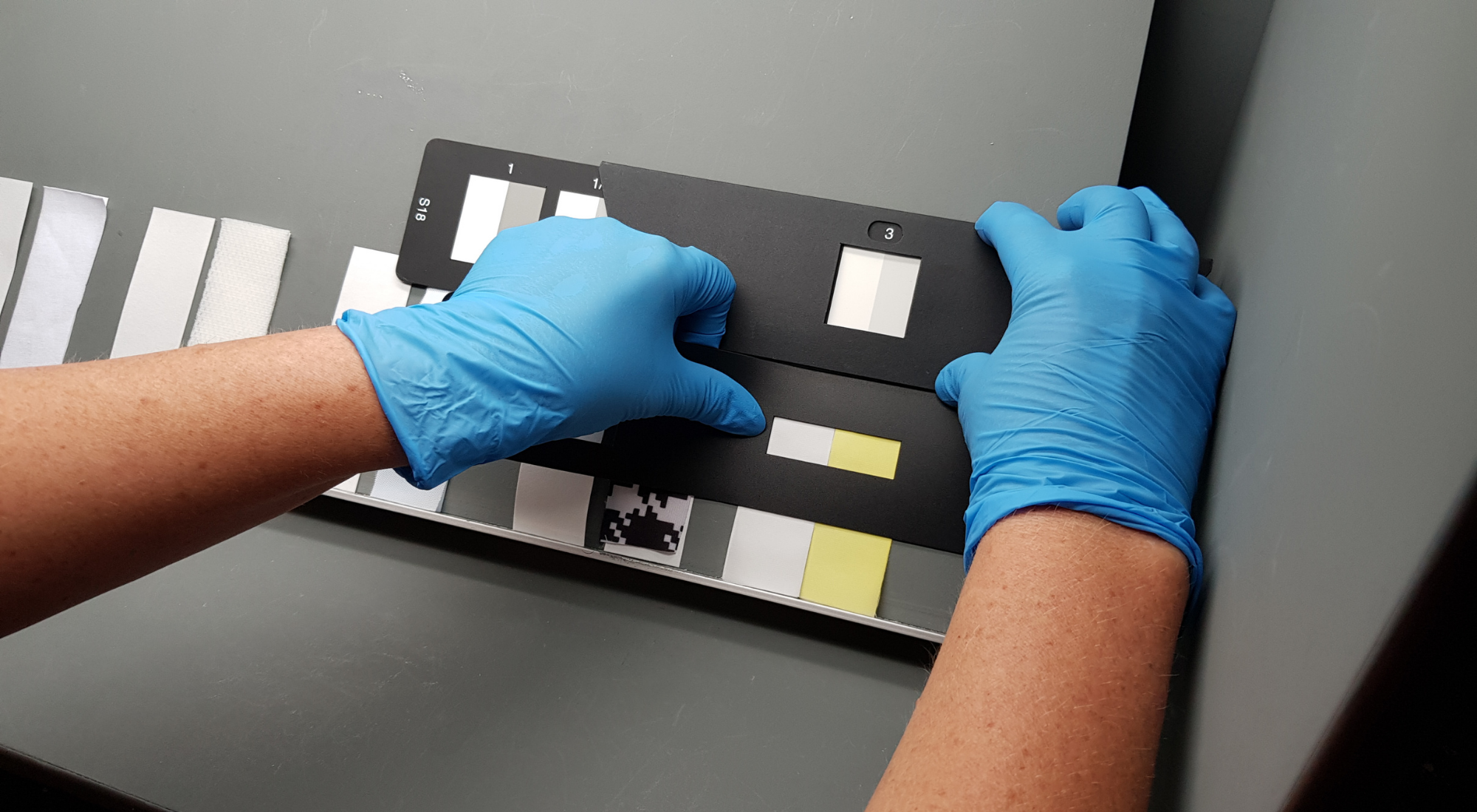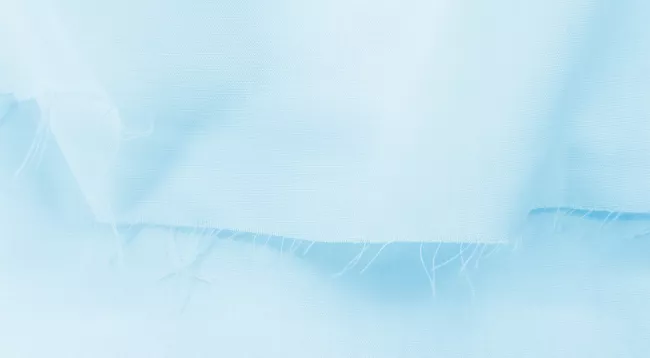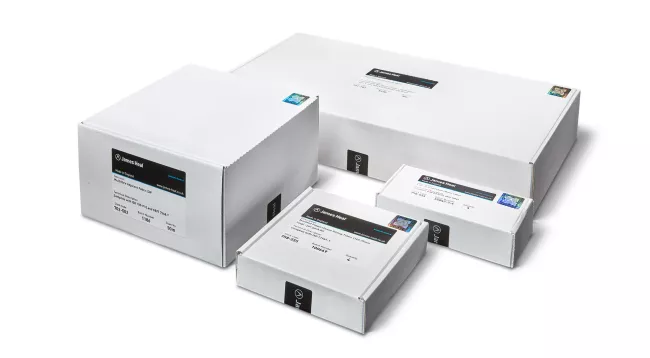Phenolic Yellowing in garments occurs when certain conditions are present while fabrics or garments are being stored.
These are an alkaline finishing, nitrogen dioxide present in the air, and the presence of phenols, this is often from storage in polyethylene bags or film containing butylated hydroxyl toluene or similar compounds.
We recently conducted a webinar about how phenolic yellowing happens and how you test for it, which you can watch you can watch on-demand.
Our attendees asked many interesting questions on this subject - explore our answers below.
Which chemicals are on the impregnated test papers, and are these chemicals hazardous?
How long does it take until textiles show phenolic yellowing in the warehouse or storage?
Have any studies shown if testing 3 packages at the same time has an impact on results?
How can you ensure gloves won't pollute the phenolic yellowing test?
To prevent yellowing, an acid bath is an option. Does it matter which acid is used?
If our suppliers start producing packaging that doesn't contain BHT, will that reduce the risk of phenolic yellowing?
Can the ISO 105 X18 test for Phenolic Yellowing be used for leather or thermoplastic rubbers?
Do you have to check the pH of the fabric to predict phenolic yellowing, and what should the pH be?
We sometimes see uneven staining on our specimens, should we re-test?
Is dry cleaning a solution to recover phenolic yellowing?
Can you recommend a pH value which the fabric should have after acidic finishing?
What types of yellowing can occur on synthetic textiles?
Which plays a bigger role, yellowing while wearing clothes or while they are stored?
What temperature do you test your samples at for phenolic yellowing, and how long does the test take?
Are there any downsides to using packaging that doesn’t contain BHT?
Is the ISO 105 X18 test applicable for coated textiles as well, such as polyurethane coated fabrics?
How do you recover garments where phenolic yellowing has occurred?
Other Useful Links
Access our on-demand Phenolic Yellowing Webinar for more information
Read our Guide to Phenolic Yellowing
Read more about the products: Test Device | Test Materials
Which chemicals are on the impregnated test papers, and are these chemicals hazardous?
Answer
The chemical used on impregnated test papers is < 0,1 % 2,6-di-tert-butyl-4-nitrophenol.
The papers are not subject to legislation concerning toxic substances, and no hazardous reactions are known.
The papers have been tested for acute dermal irritation in accordance with the method described in the OECD Guidelines for Testing of Chemicals (1981) No.404 ‘Acute Dermal Irritation/Corrosion’. As a result of such testing the papers have been classed as non irritant.
However it is advised that normal laboratory procedures for the safe handling of chemicals should be observed when handling the papers i.e. avoid skin contact, use gloves for handling, do not ingest and wash hands after use.
You can read more on the Material Safety Data Sheet for Impregnated Test Papers here.
How long does it take until textiles show phenolic yellowing in the warehouse or storage?
Answer
Pinpointing a time when yellowing will occur is impossible without knowing the exact conditions of:
- storage conditions
- the packaging used
- the pH value of the textile
However, it is recommended to keep storage time to a minimum, studies have found that fabrics that are susceptible to yellowing should not be stored longer than 3 months, as this is when yellowing really kicks in.
Have any studies shown if testing 3 packages at the same time has an impact on results?
Answer
The standard states that each test device can and must accept three packages, one on top of the other, whether or not they contain test specimens, so we would not expect this to have any impact on your results.
You can see in our phenolic yellowing webinar that our test device has two blank packages and only one with test specimens and the control fabric in.
All trials of this nature will have been conducted when the standard was formulated by the standard body who wrote it. Please contact the ISO for the results of the verification trials.
How can you ensure gloves won't pollute the phenolic yellowing test?
Answer
The standard advises to wear protective gloves when handling the elements of the phenolic yellowing test, but it does not advise what type of gloves to wear, so try to use gloves without BHT (or similar compounds) in them.
However, even protective gloves with BHT in them are unlikely to affect the test, as whilst wearing them there is probably not enough time for a reaction to occur. This is because the BHT/phenolic antioxidant needs to be present in the glove, and the glove be in the presence of NOx gasses for long enough for a reaction to take place. The reaction would leach the phenolic antioxidant out of the glove as a nitrated phenol; after which this has to react with the fabric which needs to have an alkaline pH for yellowing to occur.
You probably won’t have the precise conditions or your gloves on long enough for a reaction to occur. It would be good practice to ensure that you keep the gloves away from NOx gasses. If in doubt, and you write your own standard test methods, advise users of your phenolic yellowing test method to use gloves without BHT (or similar compounds) in them.
To prevent yellowing, an acid bath is an option. Does it matter which acid is used?
Answer
We have very limited documentation regarding the removal of localised stains from nylon by the ‘judicious application of dilute acetic acid’, but that yellowing may reappear over time. We do not hold any information about polyester & acetic acid in this regard unfortunately. The only other information we have is to adjust the final finish with some non volatile organic acid (but not what type of acid), and that the shade and optical brightener should be acid stable.
It is also interesting to note that yellowing can be favoured by cationic charges on the fabric (affinity of BHT-NOx reaction of products to cationic charges). So, avoidance of fabrics finished with cationic softeners or a cationic after treatment which produce cationic charges that attract antioxidants which then causes yellowing is one way of reducing the propensity for a fabric to succumb to phenolic yellowing.
If our suppliers start producing packaging that doesn't contain BHT, will that reduce the risk of phenolic yellowing?
Answer
BHT is a phenol that is widely used as an antioxidant in the manufacture of polyethylene films used for packaging. BHT sublimes and migrates easily to items in close proximity.
The use of BHT free packaging will reduce the risk of yellowing significantly, but not completely. You can also implement measures to prevent exposure to NOx gases or consider an acidic finish for your textiles.
Phenols can also be created from other things, so you would want to minimise contact with cardboard, for example.
Can the ISO 105 X18 test for Phenolic Yellowing be used for leather or thermoplastic rubbers?
Answer
The ISO 105 X18 test simply outlines testing ‘textile materials’ for phenolic yellowing. For more information, the definition for ‘textile materials’ can be found in ISO 105 A08.
We have never tried this text on leather or thermoplastic rubber, so cannot provide any data for it.
Do you have to check the pH of the fabric to predict phenolic yellowing, and what should the pH be?
Answer
There is no fixed pH and the standard for phenolic yellowing, ISO 105-X18, doesn’t ask you to test it.
As a guide: It has been suggested that to avoid phenolic yellowing preferably pH neutral or an acidic pH is required and NOT mildly alkaline between pH 6-9.
We sometimes see uneven staining on our specimens, should we re-test?
Answer
If your test specimen has yellowed in any way, whether this is uniform or not, then it is likely that it will be susceptible to phenolic yellowing.
This would not be a reason to repeat the test. The main reason to repeat is if your control fabric hasn’t yellowed to the correct level.
Is dry cleaning a solution to recover phenolic yellowing?
Answer
Standard dry cleaning has been suggested to try to remove yellowing in cotton and polyester items, but it by no means offers a guaranteed solution.
Slight yellow staining can be removed from nylon by a light normal industrial scour.
Trying to prevent phenolic yellowing is easier than trying to recover garments that have already yellowed.
Can you recommend a pH value which the fabric should have after acidic finishing?
Answer
We cannot advise how to finish a product or a pH but can say that external studies have suggested a light scour is suggested for nylon to remove phenolic yellowing. Other studies suggest the judicious application of dilute acetic acid on localised stains on nylon may reverse the yellowing but this may only be for a short while & they could return. many have taken the view that textile finishers should use citric or glycolic acids to finish fabrics to an acid stage.
It is unclear whether these would be intended to be washed out at a later date or if they might cause unforeseen problems of their own. For example, the over use of the non-volatile citric acid on cellulosic fabrics can have detrimental effects on the strength of the fabric and in some cases yellowing, particularly when dried at high temperatures.
Beyond this we cannot advise further, we recommend you undertake trials on your particular fabric to establish what finish is best.
What types of yellowing can occur on synthetic textiles?
Answer
Broadly speaking, the types of yellowing that can impact all textiles are:
- Consumer contaminants, like products worn on the skin, perspiration and laundering products
- Atmospheric pollutants, for example gases from motors or heating systems
- Fibre degradation, from humidity and warm weather
- Chemical additives, such as finishes to fabrics in the manufacturing process
- Transferred contaminants, this is phenolic yellowing
Which plays a bigger role, yellowing while wearing clothes or while they are stored?
Answer
It is difficult to say which would have the bigger impact as there are so many different factors that could play a part in this. However, consumers do accept some yellowing to garments, particularly after extended wear/sweating etc.
Yellowing while in storage is solely the responsibility of the manufacturer and/or retailer.
What temperature do you test your samples at for phenolic yellowing, and how long does the test take?
Answer
For the standard ISO 105-X18, the phenolic yellowing test device is put into the incubator oven for 16 hours at 50 degrees celsius. The oven should be pre-warmed before the test starts.
We usually run our tests overnight and complete assessment in the morning.
Are there any downsides to using packaging that doesn’t contain BHT?
Answer
BHT is used to prevent aging in packaging, but this does not mean alternatives will age differently. There have been lots of new types of packaging introduced since initial studies on phenolic yellowing were completed.
It is worth speaking to your packaging supplier to understand your options, and maybe request samples to test for yourself.
Is the ISO 105 X18 test applicable for coated textiles as well, such as polyurethane coated fabrics?
Answer
The ISO standard can be used for any fabric you are concerned will yellow, it does not specify what type of fabric it is suitable for.
How do you recover garments where phenolic yellowing has occurred?
Answer
There are two suggestions for reversing yellowing, but neither is guaranteed to work.
- Hang the yellowed items in a well-lit and airy room
- Wash or dry clean the items, they will likely require reshaping after.
Trying to prevent yellowing is more effective than trying to recover yellow garments.












